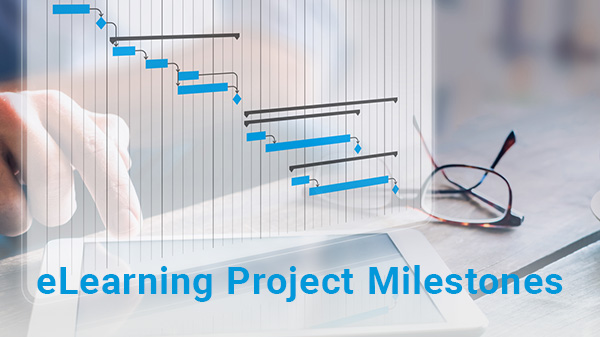The process of eLearning design and custom eLearning development consists of multiple stages that may be confusing to those who are not regularly involved in eLearning production. This guide will identify the major project milestones you should include in your next eLearning development project plan.
See the list below or download this handout as a PDF file.

- Kick-off meeting occurs
At the kick-off meeting, the team members can meet each other, set expectations for the project, agree on communication mode and frequency, etc. - The project plan is created
The project plan should include major milestones, interim milestones, delivery schedules, review cycles, etc. - The course outline is written
It is important to write a course outline before starting the actual work on the project. A well-defined outline will serve as a guide for collecting and organizing the source materials, storyboarding, content writing, etc. - Content is collected
Before any design and development occur, you should prepare all the necessary content and knowledge base sources that will be used in the project. - Content is storyboarded
An eLearning storyboard is the blueprint of the course. It’s similar to a lesson plan, with the exception that a storyboard doesn’t describe only the learning base, but also all other materials that will be produced for the course. - Course prototype is reviewed
Before developing the complete course, it’s a good idea to produce a prototype to show how the course will work, what navigation features it will include, how the learning interactions will function, etc. - Multimedia assets are produced
A modern eLearning course will most certainly require diverse multimedia content that will aid in the presentation of the material. This includes images, illustrations, stock photography, videos, interviews, voice tracks, etc. - Course is developed
After producing the storyboard and multimedia assets, the content can be put together into a comprehensive eLearning course. - Review and testing occur
The finished course should be thoroughly tested and reviewed to ensure there are no issues with the product. - Issues are addressed
With any project, problems and issues can happen anywhere in the production cycle. It is important to ensure that such issues are addressed before the final delivery takes place. - Final delivery occurs
At this stage, the content is handed over to the stakeholders and project sponsors. In addition to the learning content itself, source files, editable documents, and source materials should be cataloged and archived for future reference if needed. - Project debrief occurs
After the project completion, the project team should conduct a formal debrief session to reflect on the process, evaluate outcomes, and come up with actionable changes to make on the next project.
Next step: determine the eLearning project cost to know what to expect and be able to budget properly.
It is important to write a course outline before starting the actual work on the project. It will serve as a guide for collecting and organizing the source materials, storyboarding, content writing, etc.
An eLearning storyboard is the blueprint of the course. It’s similar to a lesson plan, but it doesn’t describe only the learning base, but also all other materials that will be produced for the course.
A modern eLearning course requires diverse multimedia content such as images, illustrations, stock photography, videos, interviews, voice tracks, etc.
The finished course should be thoroughly tested and reviewed to ensure there are no issues with the product. If any issues arise, it should be addressed first before the final delivery takes place.
In addition to the learning content itself, source files, editable documents, and source materials should be cataloged and archived for future reference if needed.


